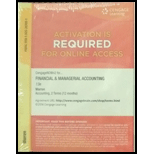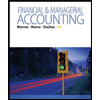
a.1.
Bonds: Bonds are long-term promissory notes that are represented by a company while borrowing money from investors to raise fund for financing the operations.
Bonds Payable: Bonds payable are referred to long-term debts of the business, issued to various lenders known as bondholders, generally in multiples of $1,000 per bond, to raise fund for financing the operations.
Discount on bonds payable: It occurs when the bonds are issued at a low price than the face value.
To Prepare:
a.1.
Explanation of Solution
Prepare journal entry for issuance of bonds payable.
| Date | Account Title and Explanation | Post Ref | Debit ($) | Credit ($) | |||
| Cash | 17,138,298 | ||||||
| Discount on Bonds Payable (1) | 1,361,702 | ||||||
| Bonds Payable | 18,500,00 | ||||||
| (To record issuance of bonds payable at discount) | |||||||
Table (1)
Working note:
Calculate discount on bonds payable.
- Cash is an asset and it is increased. So, debit it by $17,138,298.
- Discount on Bonds Payable is an adjunct liability account and it is decreased. So, debit it by $1,361,702.
- Bonds payable is a liability and it is increased. So, credit it by $18,500,000.
2.
To Prepare: Journal entry to record first interest payment and amortization of discount on bonds.
2.
Explanation of Solution
Prepare journal entry for first interest payment and amortization of discount on bonds.
| Date | Account Title and Explanation | Post Ref | Debit ($) | Credit ($) | |||
| Interest Expense (4) | 1,061,170 | ||||||
| Discount on Bonds Payable (2) | 136,170 | ||||||
| Cash (3) | 925,000 | ||||||
| (To record semiannual payment of interest and amortization of discount on bonds) | |||||||
Table (2)
Working notes:
Calculate discount on bonds payable semiannually.
Calculate the amount of cash interest.
Calculate the interest expense on the bond.
- Interest expense is an expense and it decreases the equity value. So, debit it by $1,061,170.
- Discount on Bonds Payable is an adjunct liability account and it is increased. So, credit it by $136,170.
- Cash is an asset and it is decreased. So, credit it by $925,000.
3.
To Prepare: Journal entry to record second interest payment and amortization of discount on bonds.
3.
Explanation of Solution
Prepare journal entry for second interest payment and amortization of discount on bonds.
| Date | Account Title and Explanation | Post Ref | Debit ($) | Credit ($) | |||
| Interest Expense (7) | 1,061,170 | ||||||
| Discount on Bonds Payable (5) | 136,170 | ||||||
| Cash (6) | 925,000 | ||||||
| (To record semiannual payment of interest and amortization of discount on bonds) | |||||||
Table (3)
Working notes:
Calculate discount on bonds payable semiannually.
Calculate the amount of cash interest.
Calculate the interest expense on the bond.
- Interest expense is an expense and it decreases the equity value. So, debit it by $1,061,170.
- Discount on Bonds Payable is an adjunct liability account and it is increased. So, credit it by $136,170.
- Cash is an asset and it is decreased. So, credit it by $925,000.
b.
The amount of bond interest expense for first year.
b.
Explanation of Solution
Determine the amount of bonds interest expense for first year.
c.
To Explain: The reason why the company was able to issue the bonds for $17,138,298 rather than $18,500,000.
c.
Explanation of Solution
Company P was able to issue the bonds for $17,138,298 rather than $18,500,000 because of the following reasons:
- The market interest rate (12%) of bonds was higher than the stated interest rate of 10%.
- The bonds were less valuable in market and investors were ready to pay less than the maturity
value of bonds
Want to see more full solutions like this?
Chapter 12 Solutions
CengageNOWv2, 2 terms Printed Access Card for Warren?s Financial & Managerial Accounting, 13th, 13th Edition
- There are different tools for analyzing the financial statements of a company, such as horizontal analysis, vertical analysis, ratios for measuring financial health and profitability, and so forth. Why do we need different tools for analyzing financial statements? Don't the numbers in the financial statements speak for themselves?arrow_forwardPlease help me solve this financial accounting question using the right financial principles.arrow_forwardSales made in fiscal 2025 for $50,000,000 include a 5-year warranty coverage. The estimated cost for warranty is expected to be 2% for each of the first 4 years and 5% for the last year. Determine how much warranty expense will be recorded in fiscal 2025. Question 2 options: $6,500,000 $4,000,000 $1,000,000 $5,000,000arrow_forward
- Agree or disagree with the post Financial statements provide raw data, but without analysis, they lack meaningful insight. Different tools help uncover trends, assess financial health, and compare performance effectively. Horizontal analysis tracks changes over time, identifying growth patterns or declines. Vertical analysis expresses financial items as percentages of a base figure, making comparisons across companies easier. Like liquidity, profitability, and solvency measures, ratios offer critical efficiency, risk, and stability assessments. These tools translate numbers into actionable intelligence, helping businesses, investors, and analysts spot risks, make informed decisions, and drive strategic planning. Without them, financial statements can be overwhelming and lack clarity. Agree or disagree with the postarrow_forwardWhat was the gain or loss on the disposal?arrow_forwardCompute the gain or loss on the transfer of equipment.arrow_forward
- What is the cost of unused capacity?arrow_forwardA $100,000 5-year 6% bond is issued on January 1, 2026. The bond pays interest annually. The market rate is 7%. What is the selling price of the bonds, rounded to the nearest dollar? Question 6 options: $104,213 $95,900 $100,000 $4,100arrow_forwardA $100,000 5-year 6% bond is issued on January 1, 2026. The bond pays interest annually. The market rate is 7%. What is the selling price of the bonds, rounded to the nearest dollar? Question 6 options: $104,213 $95,900 $100,000 $4,100arrow_forward
- Dell Industries has a normal capacity of 30,000 direct labor hours. The company's variable costs are $45,000, and its fixed costs are $27,000 when operating at normal capacity. What is its standard manufacturing overhead rate per unit?arrow_forwardWhich statement about a "treasury shares" is correct? Question 10 options: These shares continue to have voting rights. These shares must be cancelled upon re-purchase. The company does not pay dividends on these shares. These shares are disclosed as issued and outstanding.arrow_forwardWhich statement best describes the accounting when a company cancels its own shares at an amount higher than the average share value? Question 9 options: Contributed surplus and retained earnings will be debited. Contributed surplus will be debited, thereby decreasing equity. Contributed surplus and retained earnings will be credited. Contributed surplus will be credited, thereby increasing equity.arrow_forward
 College Accounting, Chapters 1-27AccountingISBN:9781337794756Author:HEINTZ, James A.Publisher:Cengage Learning,
College Accounting, Chapters 1-27AccountingISBN:9781337794756Author:HEINTZ, James A.Publisher:Cengage Learning, Excel Applications for Accounting PrinciplesAccountingISBN:9781111581565Author:Gaylord N. SmithPublisher:Cengage LearningPrinciples of Accounting Volume 1AccountingISBN:9781947172685Author:OpenStaxPublisher:OpenStax College
Excel Applications for Accounting PrinciplesAccountingISBN:9781111581565Author:Gaylord N. SmithPublisher:Cengage LearningPrinciples of Accounting Volume 1AccountingISBN:9781947172685Author:OpenStaxPublisher:OpenStax College Cornerstones of Financial AccountingAccountingISBN:9781337690881Author:Jay Rich, Jeff JonesPublisher:Cengage Learning
Cornerstones of Financial AccountingAccountingISBN:9781337690881Author:Jay Rich, Jeff JonesPublisher:Cengage Learning Financial AccountingAccountingISBN:9781305088436Author:Carl Warren, Jim Reeve, Jonathan DuchacPublisher:Cengage Learning
Financial AccountingAccountingISBN:9781305088436Author:Carl Warren, Jim Reeve, Jonathan DuchacPublisher:Cengage Learning Financial & Managerial AccountingAccountingISBN:9781285866307Author:Carl Warren, James M. Reeve, Jonathan DuchacPublisher:Cengage Learning
Financial & Managerial AccountingAccountingISBN:9781285866307Author:Carl Warren, James M. Reeve, Jonathan DuchacPublisher:Cengage Learning





